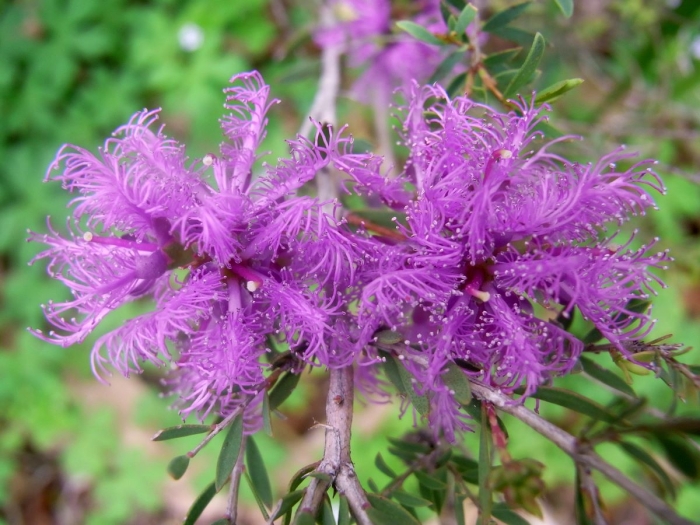Thyme Honey-Myrtle
(Melaleuca thymifolia)
Thyme Honey-Myrtle (Melaleuca thymifolia)
/
/

Poyt448 Peter Woodard
Public domain
Image By:
Poyt448 Peter Woodard
Recorded By:
Copyright:
Public domain
Copyright Notice:
Photo by: Poyt448 Peter Woodard | License Type: Public domain | License URL: https://creativecommons.org/public-domain/ | Uploader: Poyt448 | Publisher: Wikimedia Commons | Title: Melaleuca_thymifolia_RBGS.JPG | Notes: Strong, M. T., 6164. Habit: fruits. Melanthium virginicum. |















Estimated Native Range
Summary
Melaleuca thymifolia, commonly known as Thyme Honey-myrtle, is a fragrant, evergreen shrub native to coastal swamps and wet heathlands in eastern Australia. It typically grows to about 1.0 m (3 ft) tall and can spread to 3 meters (10 ft) wide. The plant features corky bark and slender, wiry stems. Thyme Honey-myrtle is renowned for its attractive, purple flowers that appear mostly in spring, although sporadic flowering can occur at other times of the year. The flowers are showy and are followed by distinctive woody, cup-shaped capsules. Its graceful form, coupled with the adaptability to a wide range of soils and conditions, makes it one of the most commonly cultivated species within its genus.
Thyme Honey-myrtle is valued for its beautiful flowers, ease of maintenance, and resilience to frost and drought. It is long-lived and does best in well-watered situations but can tolerate various conditions. This shrub is ideal for use in ornamental gardens, as a border plant, or for naturalizing in wet areas. It requires full sun to thrive and prefers soils with slow to medium drainage. While it is generally pest and disease-resistant, root rot can occur in poorly drained soils. Thyme Honey-myrtle is not known for aggressive roots or significant disease problems, making it a low-maintenance choice for gardeners.CC BY-SA 4.0
Thyme Honey-myrtle is valued for its beautiful flowers, ease of maintenance, and resilience to frost and drought. It is long-lived and does best in well-watered situations but can tolerate various conditions. This shrub is ideal for use in ornamental gardens, as a border plant, or for naturalizing in wet areas. It requires full sun to thrive and prefers soils with slow to medium drainage. While it is generally pest and disease-resistant, root rot can occur in poorly drained soils. Thyme Honey-myrtle is not known for aggressive roots or significant disease problems, making it a low-maintenance choice for gardeners.CC BY-SA 4.0
Plant Description
- Plant Type: Shrub
- Height: 3-3.5 feet
- Width: 3-6 feet
- Growth Rate: Moderate
- Flower Color: Purple
- Flowering Season: Fall
- Leaf Retention: Evergreen
Growth Requirements
- Sun: Full Sun
- Water: Medium
- Drainage: Slow, Medium
Common Uses
Bee Garden, Bird Garden, Butterfly Garden, Fragrant, Groundcover, Hummingbird Garden, Low Maintenance, Showy Flowers, Street Planting
Natural Habitat
Coastal swamps and wet heathlands
Other Names
Common Names: Thymeleaf Melaleuca
Scientific Names: , Melaleuca thymifolia, Melaleuca coronata, Melaleuca gnidiifolia, Metrosideros calycina, Melaleuca parvifolia, Melaleuca discolor, Melaleuca fimbriata, Melaleuca serpyllifolia, Myrtoleucodendron thymifolium
GBIF Accepted Name: Melaleuca thymifolia Sm.